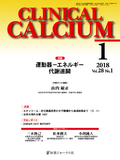Japanese
English
特集 運動器-エネルギー代謝連関
Review
老化に伴う運動器とエネルギー代謝の変動
Aging-related changes in motor organs and energy metabolism.
矢可部満隆
1
,
秋下雅弘
2
Yakabe Mitsutaka
1
,
Akishita Masahiro
2
1東京大学医学部附属病院老年病科・助教
2東京大学医学部附属病院老年病科・教授
1Department of Geriatric Medicine, The University of Tokyo, Japan.
2Department of Geriatric Medicine, The University of Tokyo, Japan.
pp.17-22
発行日 2017年12月28日
Published Date 2017/12/28
DOI https://doi.org/10.20837/4201801017
- 有料閲覧
- Abstract 文献概要
- 1ページ目 Look Inside
- 参考文献 Reference
老化に伴い,骨格筋では筋量と筋力の減少,速筋線維の減少,筋肉の質の低下が見られ,サルコペニアをきたす。骨では骨吸収が骨形成を上回り,特に女性では骨量が顕著に減少し,骨粗鬆症をきたす。運動器は脳から末梢神経に至る神経系によって制御されているが,神経系の老化により,運動機能が低下する。骨格筋量の低下と体脂肪の増加はインスリン抵抗性を増大させ,インスリン分泌能の低下と合わさり,耐糖能低下をきたす。蛋白合成能低下も筋量の減少に関与する。
Aging causes loss of skeletal muscle mass and strength, which is termed as sarcopenia. Aging of the neurological system may affect motor organs. Reduced muscle mass and increased fat mass induce insulin resistance, which is one of the causes for impaired glucose tolerance in the elderly.



